Physical Address
304 North Cardinal St.
Dorchester Center, MA 02124
Perivascular tumors recapitulate the appearance of the modified myoid cells that support or invest blood vessels (i.e., glomus cell and pericyte). Sometimes referred to as perivascular myoid tumors, these include glomus tumor and its variants, myopericytoma, myofibroma/myofibromatosis, and sinonasal glomangiopericytoma (hemangiopericytoma-like tumor). So-called hemangiopericytoma, although a distinctive lesion histologically, does not display true pericytic differentiation but shares many histologic, immunophenotypic and cytogenetic features with solitary fibrous tumor. The consensus is that hemangiopericytoma and solitary fibrous tumor are part of the same spectrum of lesions, and of uncertain lineage, and they are discussed together in Chapter 32 .
The glomus tumor is a distinctive neoplasm that resembles the normal glomus body. It was originally considered a form of angiosarcoma until Masson published his classic paper in 1924, based on observations of three patients who had experienced strikingly similar symptoms. Each suffered paroxysms of lancinating pain in the upper extremity that abated abruptly after removal of the tumor. Masson compared the tumors to the normal glomus body and suggested that the lesion represented hyperplasia or overgrowth of this structure.
The normal glomus body is a specialized form of arteriovenous anastomosis that regulates heat. It is located in the stratum reticularis of the dermis and is most frequently encountered in the subungual region, the lateral areas of the digits, and the palm. Glomus bodies are also identified in the precoccygeal soft tissue as one or more grouped structures (glomus coccygeum) varying in diameter from less than 1 to 4 mm. According to Popoff, the structure does not develop until several months after birth and gradually undergoes atrophy during late adult life. Although it may be damaged in certain disease states, there is evidence that it may regenerate, probably as a result of differentiation of perivascular cells. The glomus body is made up of an afferent arteriole derived from the small arterioles supplying the dermis and branching into two or four preglomic arterioles ( Figs. 24.1 to 24.3 ). These arterioles are endowed with the usual complement of muscle cells and an internal elastic lamina, but they blend gradually into a thick-walled segment with an irregular lumen known as the Sucquet-Hoyer canal . This region is the arteriovenous anastomosis proper and is lined by plump cuboidal endothelial cells, which in turn are surrounded by longitudinal and circular muscle fibers but no elastic tissue. Scattered throughout the muscle fibers are the rounded, epithelioid “glomus” cells. These canals drain into a series of thin-walled collecting veins. The entire glomic complex is encompassed by lamellated collagenous tissue containing small nerves and vessels.
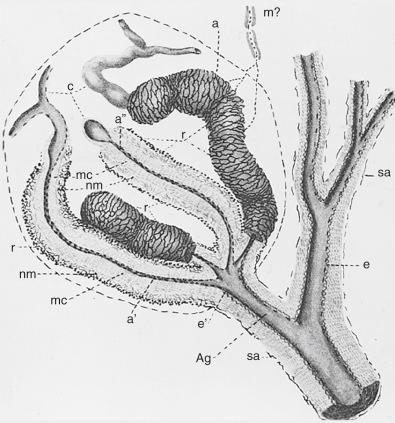
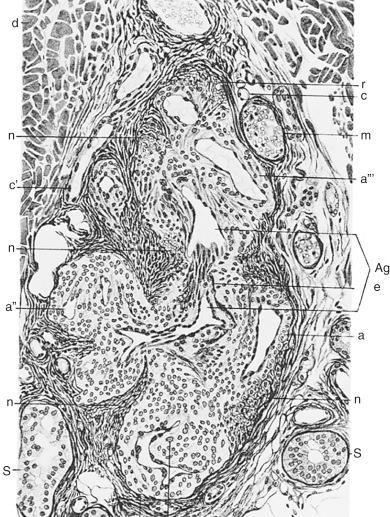
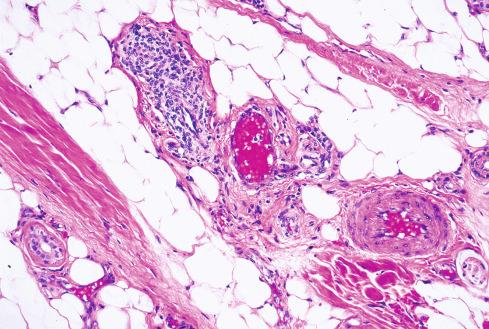
Glomus tumors are uncommon, with an estimated incidence of 1.6% among the 500 consecutive soft tissue tumors reported from the Mayo Clinic. The tumor is about equally common in both genders, although there is a striking female predominance (3:1) among patients with subungual lesions. Multiple subungual glomus tumors have been reported in neurofibromatosis 1 (NF1). Most glomus tumors are diagnosed during adult life (ages 20-40), although often symptoms have been present for several years before the diagnosis. The lesions develop as small, blue-red nodules usually located in the deep dermis or subcutis of the upper or lower extremity. The most common site is the subungual region of the finger, but other common sites include the palm, wrist, forearm, and foot ( Table 24.1 ). Glomus tumors probably also occur in the subcutaneous tissue near the tip of the spine, where they presumably arise from the glomus coccygeum ( Fig. 24.4 ). However, many “incidental” glomus tumors arising in the region of the coccyx may well represent the normal glomus coccygeum, since this structure can reach several millimeters in diameter in the absence of clinical symptoms suggesting a neoplasm. Rare glomus tumors have been reported in almost every location, including the gastrointestinal (GI) tract, penis, bladder, mediastinum, nerve, bone, and lung. Classic glomus tumors are typically solitary.
| Glomus Tumor | Glomangioma | Glomangiomyoma | ||||
|---|---|---|---|---|---|---|
| Anatomic Location | No. Cases | % | No. Cases | % | No. Cases | % |
| Upper extremities | 176 | 34 | 45 | 9 | 16 | 3 |
| Finger | 81 | 9 | 3 | |||
| Lower extremities | 98 | 19 | 29 | 6 | 14 | 3 |
| Head and neck | 29 | 6 | 6 | 1 | 5 | 1 |
| Trunk | 24 | 5 | 8 | 2 | 0 | 0 |
| Other | 45 | 9 | 4 | 1 | 7 | 1 |
| total | 372 | 73 | 92 | 19 | 42 | 8 |
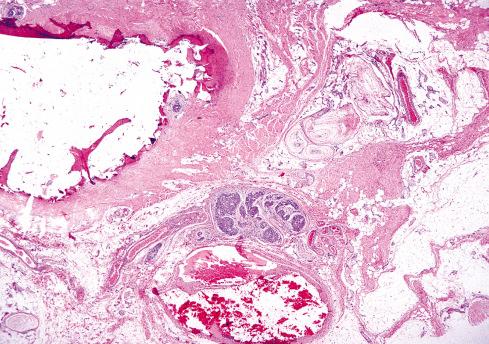
The symptoms produced by glomus tumors are characteristic and often greatly out of proportion to the size of the neoplasm. Paroxysms of pain radiating away from the lesion are the most common complaint. These episodes can be elicited by changes in temperature, particularly exposure to cold, and tactile stimulation of even minor degree. In some patients the pain is accompanied by additional signs of hypesthesia, muscle atrophy, or osteoporosis of the affected part. In unusual cases, disturbances of autonomic function (e.g., Horner syndrome) have been reported. Although the mechanism of pain production has not been fully elucidated, identification of nerve fibers containing immunoreactive substance P (a pain-associated vasoactive peptide) in glomus tumors suggests pain mediation through its release.
Grossly, the lesions are small, blue-red nodules (usually <1 cm) that are immediately apparent on clinical examination. Subungual lesions may be more difficult to detect, and care should be taken to look for ridging of the nail or discoloration of the nail bed. Radiographs are helpful when they demonstrate a small, scalloped osteolytic defect with a sclerotic border in the terminal phalanx, which is highly characteristic of a glomus tumor and epidermal inclusion cyst ( Fig. 24.5 ). The more recent use of high-resolution magnetic resonance imaging (MRI) offers the promise of detecting extremely small, soft tissue–based lesions.
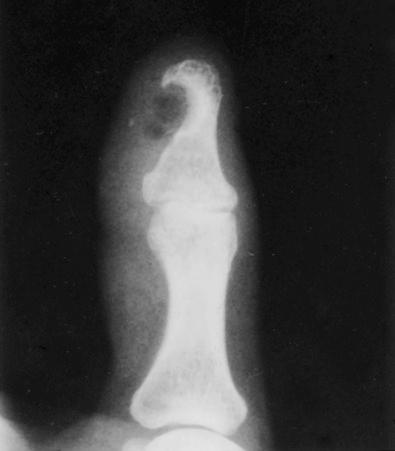
Classic glomus tumors are most common in the upper extremity and have a marked predilection for the finger, particularly the subungual region. The common form of glomus tumor accounts for about three-fourths of all cases in our material ( Table 24.1 ). It is a well-circumscribed lesion consisting of tight convolutes of capillary-sized vessels surrounded by collars of glomus cells set in a hyalinized or myxoid stroma ( Fig. 24.6 ). Rarely, it appears as a poorly circumscribed, diffuse lesion. Depending on the size of the nests of glomus cells, the tumor may have a vascular appearance reminiscent of a solitary fibrous tumor or paraganglioma or a cellular appearance suggestive of an epithelial tumor ( Fig. 24.7 ). The glomus cell is distinctive, and its appearance is one of the most reliable means of distinguishing this tumor from others with similar growth patterns. The cell has a rounded, regular shape with a sharply punched-out, rounded nucleus set off from the amphophilic or eosinophilic cytoplasm ( Fig. 24.8 ). The outlines of the cells are not fully appreciated on routine hematoxylin-eosin–stained sections but can be accentuated with a periodic acid–Schiff (PAS) or toluidine blue stain. In these preparations a “chicken-wire” network of matrix material is present between the cells.
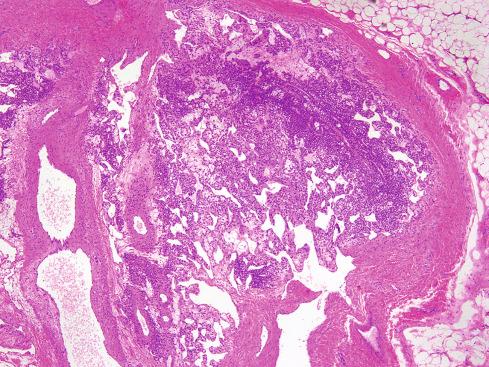
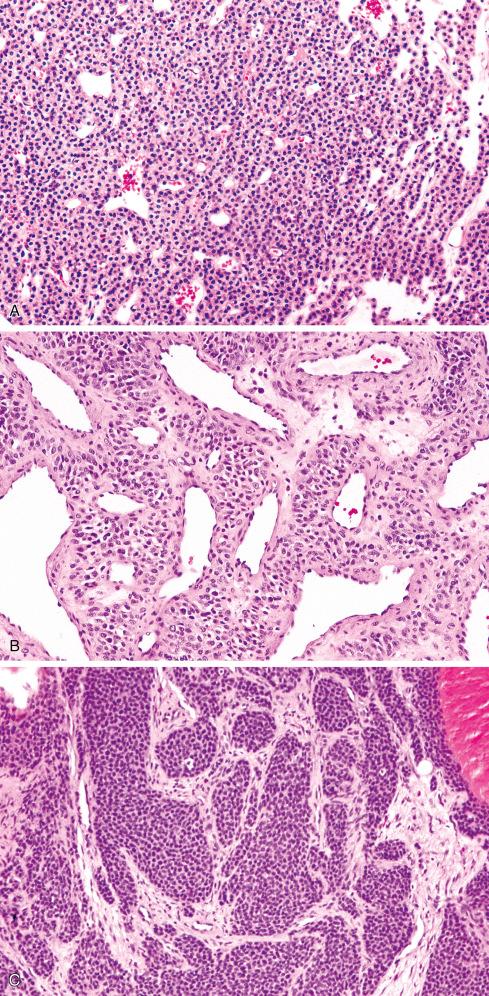
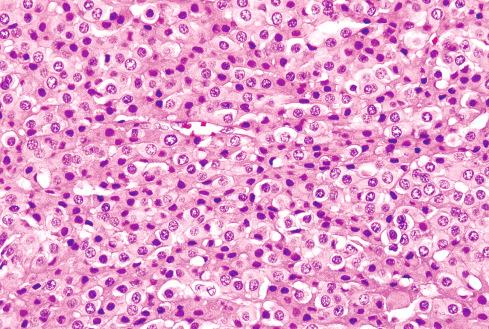
Only rarely do glomus cells deviate from the foregoing description, but when they do, alterations in either the nucleus or the cytoplasm may be seen. Large hyperchromatic nuclei, probably representing a degenerative change, may replace the typical round, regular nuclei. If this change is present as an isolated finding in an otherwise typical glomus tumor, it should not be equated with malignancy. Such tumors are referred to as “symplastic glomus tumors” (see later). A less common phenomenon is the acquisition of abundant granular, eosinophilic cytoplasm such that portions of the tumor appear “oncocytic” ( Fig. 24.9 ). Intravascular growth and signet-ring changes in the cells have been noted in a multifocal gastric glomus tumor.
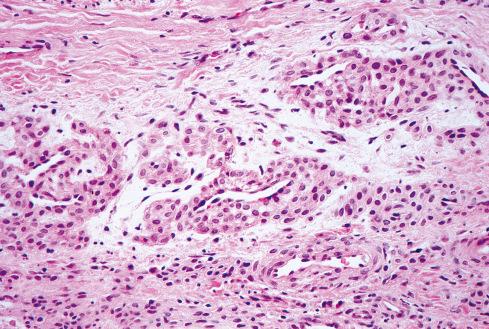
Although the cells are regarded as variants of smooth muscle cells, the cytoplasm is usually devoid of glycogen, and there is only minimal fuchsinophilia observed on staining with the Masson trichrome stain, two features that contrast with the staining reactions of conventional smooth muscle cells. Peripherally, the tumors have an ill-defined rim of collagen containing small nerves and vessels. This rim seldom serves as a complete or totally confining capsule, because isolated nests of glomus cells can be identified outside its boundaries and occasionally in the walls of small vessels surrounding the main tumor mass ( Fig. 24.10 ). Vascular invasion is rarely seen in benign glomus tumors and does not appear to be predictive itself of malignancy.
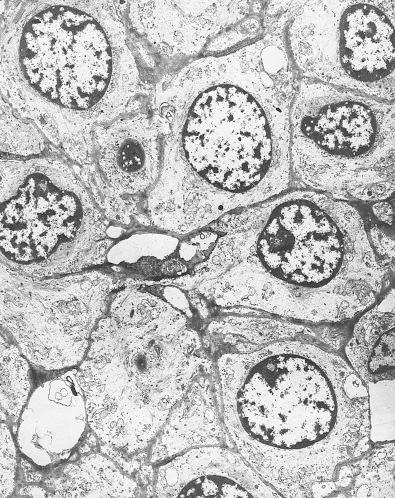
Because glomus tumors are quite distinctive by virtue of their characteristic cells, location, and symptoms, errors in diagnosis are infrequent. Nonetheless, it has been our experience that highly cellular glomus tumors are occasionally mistaken for adnexal tumors or less frequently intradermal nevi. In the former instance, it is important to note the intimate relation of glomus cells around small vessels at the periphery of the tumor ( Fig. 24.10 ) and the total lack of ductular differentiation or epithelial mucin production. Immunohistochemistry (IHC) can reliably discriminate glomus tumors from solid forms of hidradenoma (the adnexal tumor most closely resembling a glomus tumor). Virtually all hidradenomas express keratins, whereas glomus tumors do not. In addition, hidradenomas frequently also express carcinoembryonic antigen (CEA) and epithelial membrane antigen (EMA), which are not encountered in glomus tumors. Likewise, S-100 protein is a reliable marker for distinguishing melanocytic nevi from glomus tumors.
Ultrastructurally glomus cells are filled with thin (8-nm) actinlike filaments and are invested by a thick, often continuous basal lamina ( Fig. 24.11 ). Both features can be exploited by IHC for diagnosis. Specifically, vimentin and muscle actin isoforms can be identified in almost all glomus tumors ( Fig. 24.12A ). Desmin, however, is highly variable. Heavy-caldesmon may be present. Laminin and type IV collagen, two constituents of basal lamina, outline the cells or small groups of cells ( Fig. 24.12B ). BRAFv600E expression may be seen in a minority of malignant glomus tumors, typically corresponding to the presence of BRAF mutations.
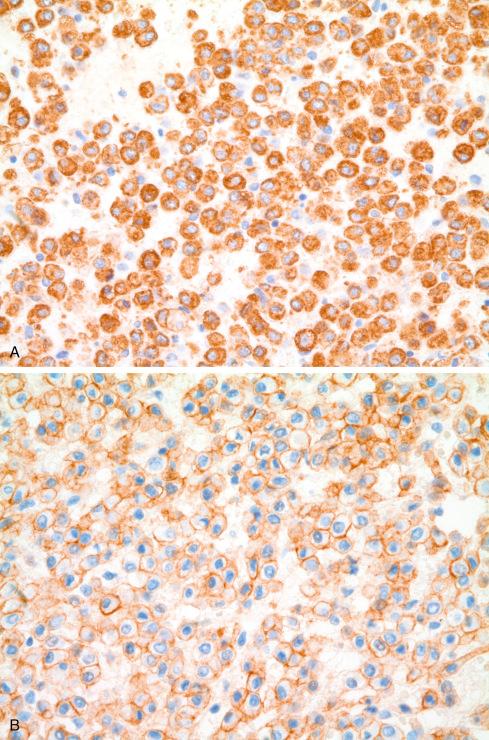
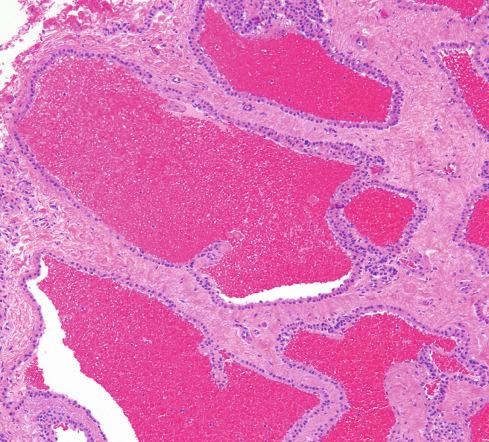
Mosquera et al. described rearrangements in NOTCH genes in approximately 60% of glomus tumors. NOTCH genes are thought to be involved in the regulation of vascular smooth muscle development. Rearrangements of the NOTCH2 gene were found in 52% of cases, most often fused with MIR143 , and were identified in both malignant and benign glomus tumors. NOTCH3 rearrangements were found in 9% of cases, all showing benign histology, and a single case was positive for NOTCH1 rearrangement. Recently, Chakrapani et al. identified BRAF V600E mutations in 11% of glomus tumors, a finding confirmed by Karamzadeh Dashti et al., who noted a significant association between BRAF V600E mutations and atypical characteristics, including deep location, large size, infiltrative growth, and classification as either malignant glomus tumor or glomus tumor of uncertain malignant potential (see later). A single case of malignant glomus tumor has been reported showing SMARCB1 mutation and loss of SMARCB1 protein expression.
Most glomus tumors are benign and can be treated adequately by simple excision. Only 10% recur following conservative excision. Uncommon local recurrences probably represent persistence of tumor after inadequate excision or infrequently a benign glomus tumor growing in a diffuse or infiltrative fashion (see later).
Glomuvenous malformations, formerly called glomangioma and considered variants of classic glomus tumor, comprise only about one-fifth of glomus lesions. They arise secondary to truncating mutations of the glomulin gene located at 1p21-22 and are likely malformations. Although glomulin is a normal component of vascular smooth muscle during embryogenesis, it is not yet understood how its functional absence relates to the development of these malformations. Based on analysis of several families with predominantly inherited lesions, four principal germline mutations have been identified. Random postzygotic mutations may explain both the variation in the number and distribution of lesions in familial cases and the occurrence of nonfamilial cases. Recent evidence, however, supports somatic uniparental isodisomy involving chromosome 1p as the mechanism underlying multifocal glomuvenous malformations.
Unlike classic glomus tumor, glomuvenous malformations occur more often during childhood, are rarely subungual, and are less likely to be painful or symptomatic. Most are on the hand and forearm. Histologically, they are usually poorly circumscribed, occasionally plaque-like lesions that resemble cavernous hemangiomas, in contrast to the classic glomus tumor, which is usually better circumscribed and more cellular. Grossly and microscopically, glomuvenous malformations resemble cavernous hemangiomas ( Figs. 24.13 to 24.15 ). They are composed of gaping veins with small clusters of glomus cells in their walls. Secondary thrombosis and phlebolith formation may occur in these lesions just as in an ordinary hemangioma.
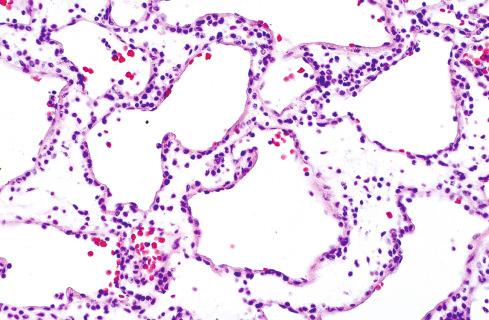
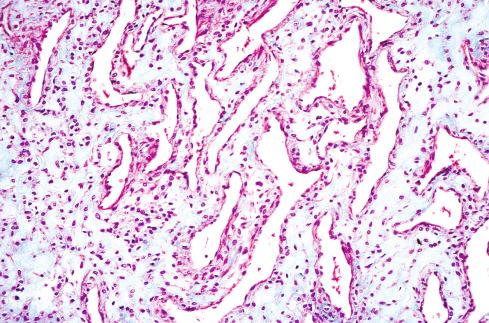
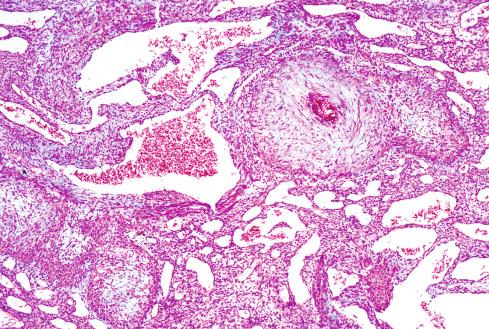
Glomangiomyomas are glomus lesions that display focal or partial smooth muscle differentiation. In actuality, most probably represent variations in either a classic glomus tumor or a glomuvenous malformation. Those glomangiomyomas with the architectural pattern of classic glomus tumor show transitions between glomus cells and cells with partial smooth muscle features, as evidenced by their fusiform shape and cytoplasmic eosinophilia. Usually, these transitional areas make up only a small portion of the lesions. In glomangiomyomas with the architectural features of a glomuvenous malformation, the glomus cells intermingle with the mature smooth muscle of the large vessels. Many cases reported in the pediatric literature as glomangiomyoma are examples of this form, and hence glomuvenous malformations ( Figs. 24.16 and 24.17 ). The term glomangiopericytoma has been used recently for glomus tumors with prominent thin- and thick-walled vessels and slight spindling of the glomus cells ( Fig. 24.18 ).
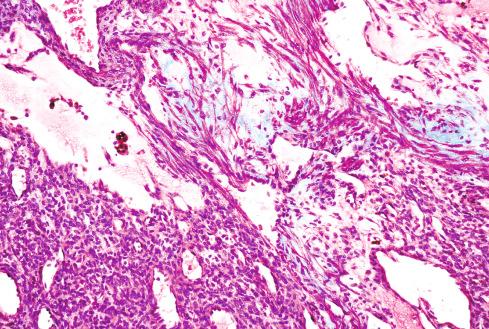
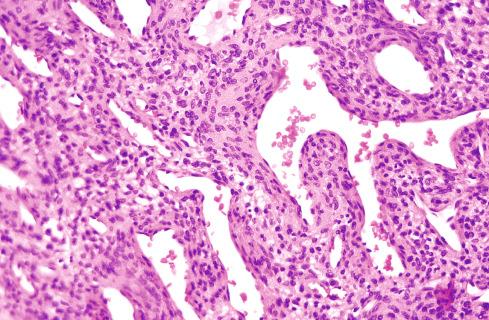
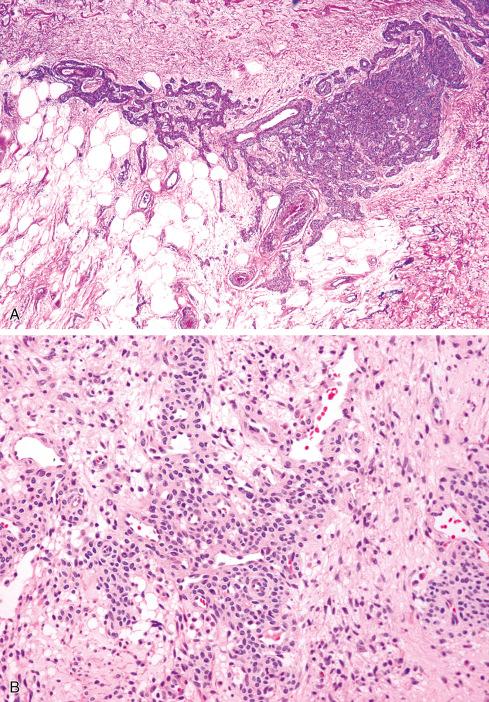
Become a Clinical Tree membership for Full access and enjoy Unlimited articles
If you are a member. Log in here